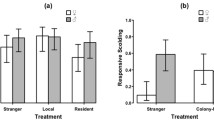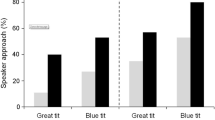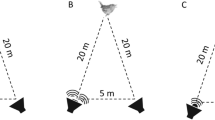Abstract
Many group-living individuals produce specific vocalizations while mobbing (when individuals move toward and harass a predator), a behavior that can recruit conspecifics. Although these vocalizations may be a source of information for heterospecifics, it remains largely unknown how heterospecifics respond to mobbing calls given by group-living species. In this study, we investigate whether the mobbing calls given by Western Australian magpies (Gymnorhina tibicen dorsalis) lead to the recruitment of heterospecifics. By presenting a taxidermied red fox (Vulpes vulpes)—representing a terrestrial predator threat—to a population of magpies and heterospecific species occupying the same area, we demonstrate that magpie calls given in response to a terrestrial predator recruit heterospecifics to the mobbing event. Heterospecifics are more likely to approach and engage in mobbing behavior when the predator is associated with magpie presence than when magpies are absent. We found that larger magpie groups produced more alarm calls than did smaller groups, but we found no evidence that group size affected heterospecific recruitment to the mobbing site. Therefore, the occurrence of magpie alarm calls, rather than the number of individuals giving alarm calls, seems to be the primary predictor of heterospecific recruitment to a mobbing site. Moreover, we used a playback experiment to test if heterospecifics responded more to single-magpie mobbing alarm calls than to single mobbing alarm calls given by a non-social species (red wattlebird, Anthochaera carunculata). We found that heterospecifics responded more to the playbacks of magpie than to red wattlebird alarm calls. Our study therefore suggests that Australian magpies may play a central role as information sources for heterospecific species during predator detection and mobbing events.
Significance statement
Mobbing—when individuals move toward and vocalize or harass a predator—is a good example of interspecific communication. Loud vocalizations produced during mobbing behavior have been known to not only modify the behavior of the predator but to also recruit individuals to the mobbing event from a variety of different species. Although the response to heterospecific mobbing calls is becoming well documented, it remains largely unknown how heterospecifics respond to the mobbing calls of group-living species, even though these species can provide significant benefits for heterospecific species sharing the same habitat (via increased vigilance and predator detection rates for example). By presenting a predator model and using a series of playback experiments, we demonstrate that group-living Western Australian magpies may play a central role as information sources during predator detection and mobbing events.






Similar content being viewed by others
Data availability
The datasets generated are available as supplementary material.
References
Ashton BJ (2017) The causes and consequences of individual variation in cognitive ability in the cooperatively breeding Australian magpie (Cracticus tibicen australis). PhD thesis, University of Western Australia
Brown ED, Farabaugh SM (1991) Song sharing in a group-living songbird, the Australian magpie, Gymnorhina Tibicen. Part III. Sex specificity and individual specificity of vocal parts in communal chorus and duet songs. Behaviour 118:244–274
Carlson NV, Healy SD, Templeton CN (2018) Mobbing. Curr Biol 28:R1081–R1082
Cunha FCRD, Fontenelle JCR, Griesser M (2017) Predation risk drives the expression of mobbing across bird species. Behav Ecol 28:1517–1523
Curio E, Ernst U, Vieth W (1978) The adaptive significance of avian mobbing. Z Tierpsychol 48:184–202
Dutour M, Cordonnier M, Léna JP, Lengagne T (2019a) Seasonal variation in mobbing behaviour of passerine birds. J Ornithol 160:509–514
Dutour M, Léna JP, Dumet A, Gardette V, Mondy N, Lengagne T (2019b) The role of associative learning process on the response of fledgling great tits (Parus major) to mobbing calls. Anim Cogn 17:1–9
Dutour M, Lena JP, Lengagne T (2016) Mobbing behaviour varies according to predator dangerousness and occurrence. Anim Behav 119:119–124
Dutour M, Léna JP, Lengagne T (2017) Mobbing calls: a signal transcending species boundaries. Anim Behav 131:3–11
Dutour M, Randler C (2021) Mobbing responses of great tits (Parus major) do not depend on the number of heterospecific callers. Ethology 127:379–384
Dutour M, Ridley AR (2020) Females sing more often and at higher frequencies than males in Australian magpies. Behav Process 172:104045
Dutour M, Walsh SL, Ridley AR (2020) Australian magpies adjust their alarm calls according to predator distance. Bioacoustics (published online. https://doi.org/10.1080/09524622.2020.1808069)
Edwards EK, Mitchell NJ, Ridley AR (2015) The impact of high temperatures on foraging behaviour and body condition in the Western Australian Magpie Cracticus tibicen dorsalis. Ostrich 86:137–144
Ellis JM (2008) Which call parameters signal threat to conspecifics in white-throated magpie-jay mobbing calls? Ethology 114:154–163
Engesser S, Ridley AR, Townsend SW (2016) Meaningful call combinations and compositional processing in the southern pied babbler. P Natl Acad Sci USA 113:5976–5981
Flasskamp A (1994) The adaptive significance of avian mobbing V. An experimental test of the ‘move on’ hypothesis. Ethology 96:322–333
Fulton GR (2010) Predation of a mardo Antechinus flavipes leucogaster by a Southern boobook, and mobbing of boobooks by other birds. Austr Field Ornithol 28:38
Goodale E, Beauchamp G, Magrath RD, Nieh JC, Ruxton GD (2010) Interspecific information transfer influences animal community structure. Trends Ecol Evol 25:354–361
Goodale E, Sridhar H, Sieving KE et al (2020) Mixed company: a framework for understanding the composition and organization of mixed-species animal groups. Biol Rev 95:889–910
Graw B, Manser MB (2007) The function of mobbing in cooperative meerkats. Anim Behav 74:507–517
Griesser M (2009) Mobbing calls signal predator category in a kin group-living bird species. Proc R Soc Lond B 276:2887–2892
Hamilton WD (1971) Geometry for the selfish herd. J Theor Biol 31:295–311
Hetrick SA, Sieving KE (2011) Antipredator calls of tufted titmice and interspecific transfer of encoded threat information. Behav Ecol 23:83–92
Higgins PJ, Peter JM, Steele WK (2001) Handbook of Australian, New Zealand and Antarctic birds, vol. 5: tyrant-flycatchers to chats. Oxford University Press, Melbourne
Hogan BG, Hildenbrandt H, Scott-Samuel NE, Cuthill IC, Hemelrijk CK (2017) The confusion effect when attacking simulated three-dimensional starling flocks. R Soc Open Sci 4:160564
Hurlbert SH (1984) Pseudoreplication and the design of ecological field experiments. Ecol Monogr 54:187–211
Hurd CR (1996) Interspecific attraction to the mobbing calls of black-capped chickadees (Parus atricapillus). Behav Ecol Sociobiol 38:287–292
Igic B, Ratnayake CP, Radford AN, Magrath RD (2019) Eavesdropping magpies respond to the number of heterospecifics giving alarm calls but not the number of species calling. Anim Behav 148:133–143
Johnstone R, Storr G (2004) Handbook of Western Australian birds. Western Australian Museum, Perth
Kaplan G, Johnson G, Koboroff A, Rogers LJ (2009) Alarm calls of the Australian magpie (Gymnorhina tibicen): predators elicit complex vocal responses and mobbing behaviour. Open Ornithol J 2:7–16
Kaplan GT (2004) Australian magpie: biology and behaviour of an unusual songbird. CSIRO Publishing, Collingwood
Kennedy RA, Evans CS, McDonald PG (2009) Individual distinctiveness in the mobbing call of a cooperative bird, the noisy miner Manorina melanocephala. J Avian Biol 40:481–490
Kern JM, Radford AN (2016) Social-bond strength influences vocally mediated recruitment to mobbing. Biol Lett 12:20160648
Koboroff A, Kaplan G, Rogers LJ (2013) Clever strategists: Australian magpies vary mobbing strategies, not intensity, relative to different species of predator. PeerJ 1:e56
Krama T, Bērziņš A, Rytkönen S, Rantala MJ, Wheatcroft D, Krams I (2012) Linking anti-predator behaviour and habitat quality: group effect in nest defence of a passerine bird. Acta Ethol 15:127–134
Krams I, Bērziņš A, Krama T (2009) Group effect in nest defence behaviour of breeding pied flycatchers, Ficedula hypoleuca. Anim Behav 77:513–517
Kroodsma DE, Byers BE, Goodale E, Johnson S, Liu WC (2001) Pseudoreplication in playback experiments, revisited a decade later. Anim Behav 61:1029–1033
Leavesley AJ, Magrath RD (2005) Communicating about danger: urgency alarm calling in a bird. Anim Behav 70:365–373
Lima HSD, Las-Casas FMG, Ribeiro JR, Gonçalves-Souza T, Naka LN (2018) Ecological and phylogenetic predictors of mobbing behavior in a tropical dry forest. Ecol Evol 8:12615–12628
Lima SL (2009) Predators and the breeding bird: behavioral and reproductive flexibility under the risk of predation. Biol Rev 84:485–513
Magrath RD, Bennett TH (2011) A micro-geography of fear: learning to eavesdrop on alarm calls of neighbouring heterospecifics. Proc R Soc Lond B 279:902–909
Magrath RD, Haff TM, Fallow PM, Radford AN (2015a) Eavesdropping on heterospecific alarm calls: from mechanisms to consequences. Biol Rev 90:560–586
Magrath RD, Haff TM, McLachlan JR, Igic B (2015b) Wild birds learn to eavesdrop on heterospecific alarm calls. Curr Biol 25:2047–2050
Maklakov AA (2002) Snake-directed mobbing in a cooperative breeder: anti-predator behaviour or self-advertisement for the formation of dispersal coalitions? Behav Ecol Sociobiol 52:372–378
Milinski M (1997) How to avoid seven deadly sins in the study of behavior. Adv Stud Behav 26:159–180
Mirville MO, Kelley JL, Ridley AR (2016) Group size and associative learning in the Australian magpie (Cracticus tibicen dorsalis). Behav Ecol Sociobiol 70:417–427
Mo M, Waterhouse DR, Hayler P, Hayler A (2016) Observations of mobbing and other agonistic responses to the Powerful Owl Ninox strenua. Aust Zool 38:43–51
Naguib M, Mundry R, Ostreiher R, Hultsch H, Schrader L, Todt D (1999) Cooperatively breeding Arabian babblers call differently when mobbing in different predator-induced situations. Behav Ecol 10:636–640
Nakagawa S, Schielzeth H (2010) Repeatability for Gaussian and non-Gaussian data: a practical guide for biologists. Biol Rev 85:935–956
Nieder A (2020) The adaptive value of numerical competence. Trends Ecol Evol 35:605–617
Nocedal J, Ficken MS (1998) Bridled titmouse (Baeolophus wollweberi). In: Poole A (ed) The birds of North America online, No. 375. Cornell Lab of Ornithology, Ithaca, New York, http://bna.birds.cornell.edu/bna/species/375
Nuechterlein GL (1981) ‘Information parasitism’ in mixed colonies of western grebes and Forster’s terns. Anim Behav 29:985–989
Ostreiher R (2003) Is mobbing altruistic or selfish behaviour? Anim Behav 66:145–149
Pettifor RA (1990) The effects of avian mobbing on a potential predator, the European kestrel, Falco tinnunculus. Anim Behav 39:821–827
Pell FSD, Potvin DA, Ratnayake CP, Fernández-Juricic E, Magrath RD, Radford AN (2018) Birds orient their heads appropriately in response to functionally referential alarm calls of heterospecifics. Anim Behav 140:109–118
Randler C (2012) A possible phylogenetically conserved urgency response of great tits (Parus major) towards allopatric mobbing calls. Behav Ecol Sociobiol 66:675–681
Randler C, Vollmer C (2013) Asymmetries in commitment in an avian communication network. Naturwissenschaften 100:199–203
Ridley AR, Nelson-Flower MJ, Thompson AM (2013) Is sentinel behaviour safe? An experimental investigation. Anim Behav 85:137–142
Ridley AR, Raihani NJ, Bell MB (2010) Experimental evidence that sentinel behaviour is affected by risk. Biol Lett 6:445–448
Ridley AR, Wiley EM, Thompson AM (2014) The ecological benefits of interceptive eavesdropping. Funct Ecol 28:197–205
Robinson SK (1985) Coloniality in the yellow-rumped cacique as a defense against nest predators. Auk 102:506–519
Silvestri AJ, Morgan K, Ridley AR (2019) The association between evidence of a predator threat and responsiveness to alarm calls in Western Australian magpies (Cracticus tibicen dorsalis). PeerJ 7:e7572
Templeton CN, Greene E (2007) Nuthatches eavesdrop on variations in heterospecific chickadee mobbing alarm calls. P Natl Acad Sci USA 104:5479–5482
Walsh SL, Townsend SW, Morgan K, Ridley AR (2019) Investigating the potential for call combinations in a lifelong vocal learner. Ethology 125:362–368
Wheatcroft D, Price TD (2013) Learning and signal copying facilitate communication among bird species. Proc R Soc B 280:20123070
Acknowledgements
We thank Eleanor Russell and Ian Rowley who originally established a study population of ringed magpies and allowed us to continue work on their Guildford population. We thank the University of Western Australia for logistical support and all past and current members of the Western Magpie Research Project, especially Lizzie Speechley and Sarah Walsh. We also thank Damien Farine and anonymous referees for helpful comments that greatly improved the manuscript.
Funding
This work was supported by grant from the Fyssen Foundation (to MD).
Author information
Authors and Affiliations
Corresponding author
Ethics declarations
Ethics approval
All tested birds returned to normal activity relatively quickly (within 5 min) following playback and predator presentations. Work was carried out under an ethical license from The University of Western Australia Animal Ethics Committee (Protocol number: RA/3/100/1656). All applicable international, national, and/or institutional guidelines for the use of animals were followed.
Conflict of interest
The authors declare no competing interests.
Additional information
Communicated by J. Podos.
Publisher's Note
Springer Nature remains neutral with regard to jurisdictional claims in published maps and institutional affiliations.
Supplementary Information
Below is the link to the electronic supplementary material.
Rights and permissions
About this article
Cite this article
Dutour, M., Kasper, J. & Ridley, A.R. Transfer of information between a highly social species and heterospecific community members. Behav Ecol Sociobiol 75, 137 (2021). https://doi.org/10.1007/s00265-021-03075-4
Received:
Revised:
Accepted:
Published:
DOI: https://doi.org/10.1007/s00265-021-03075-4




